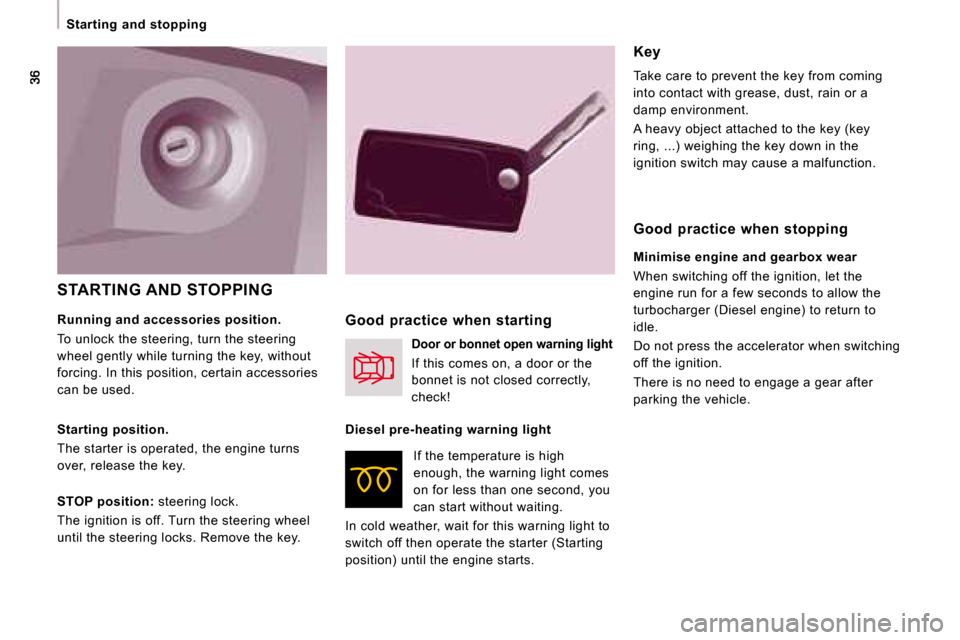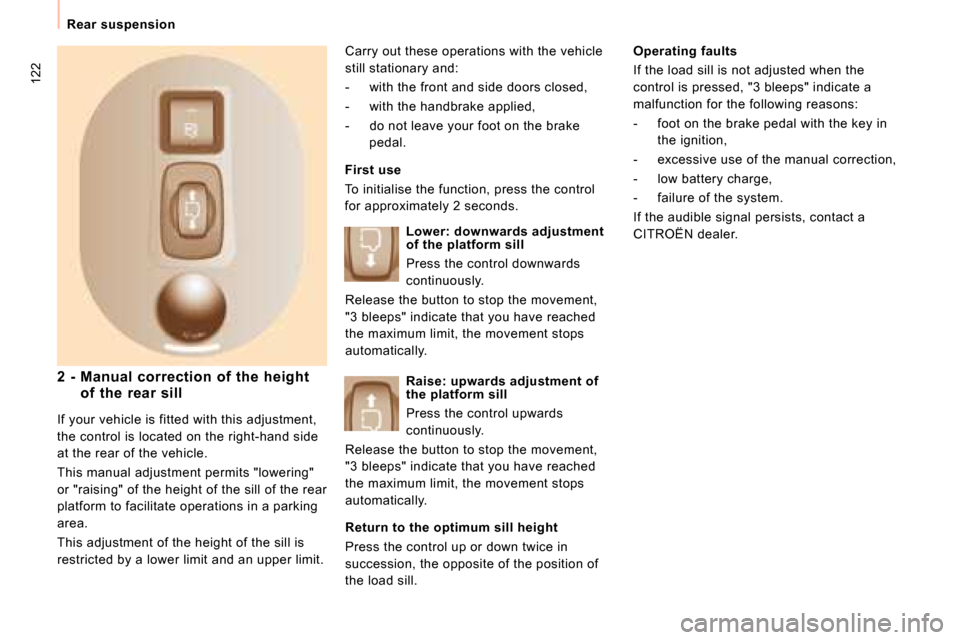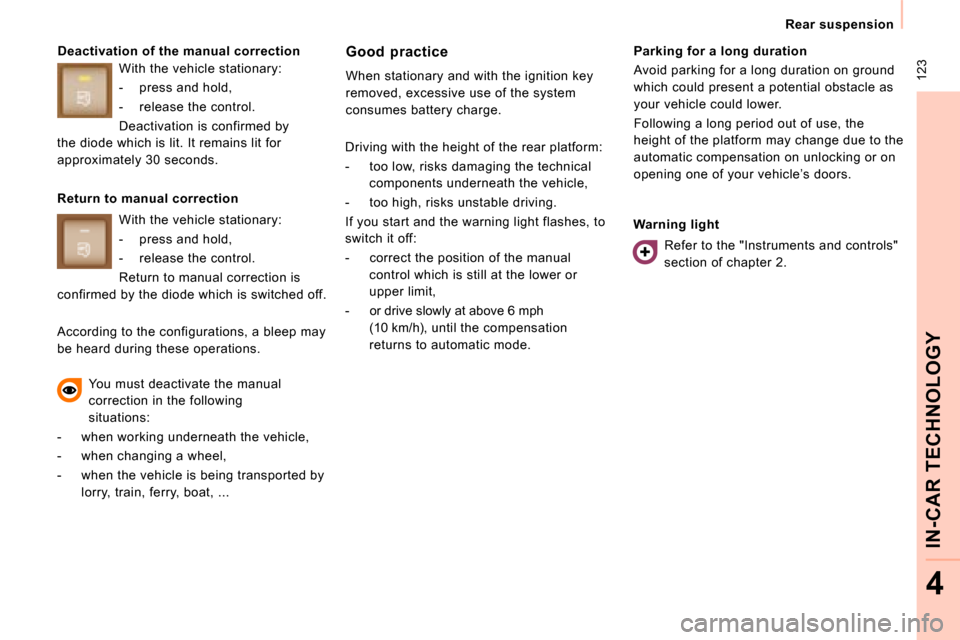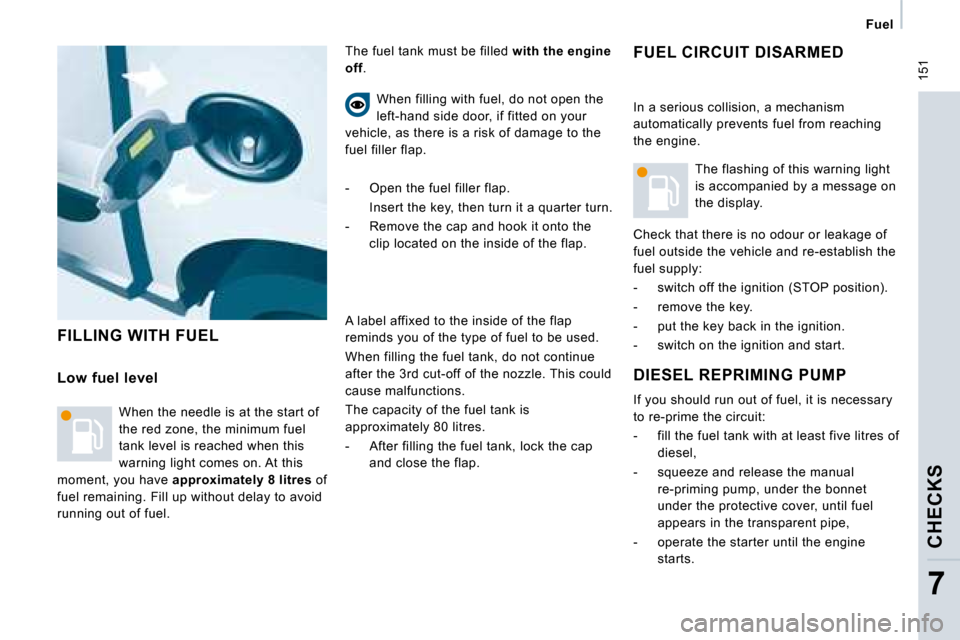key Citroen JUMPY 2008.5 2.G User Guide
[x] Cancel search | Manufacturer: CITROEN, Model Year: 2008.5, Model line: JUMPY, Model: Citroen JUMPY 2008.5 2.GPages: 185, PDF Size: 6.66 MB
Page 38 of 185

Starting and stopping
STARTING AND STOPPING
Key
Take care to prevent the key from coming
into contact with grease, dust, rain or a
damp environment.
A heavy object attached to the key (key
ring, ...) weighing the key down in the
ignition switch may cause a malfunction.
Good practice when starting
Door or bonnet open warning light
If this comes on, a door or the
bonnet is not closed correctly,
check!
Diesel pre-heating warning light If the temperature is high
enough, the warning light comes
on for less than one second, you
can start without waiting.
In cold weather, wait for this warning light to
switch off then operate the starter (Starting
position) until the engine starts. Good practice when stopping
Minimise engine and gearbox wear
When switching off the ignition, let the
engine run for a few seconds to allow the
turbocharger (Diesel engine) to return to
idle.
Do not press the accelerator when switching
off the ignition.
There is no need to engage a gear after
parking the vehicle.
Running and accessories position.
To unlock the steering, turn the steering
wheel gently while turning the key, without
forcing. In this position, certain accessories
can be used.
Starting position.
The starter is operated, the engine turns
over, release the key.
STOP position: steering lock.
The ignition is off. Turn the steering wheel
until the steering locks. Remove the key.
Page 64 of 185

63
Practical information
ERGONOMICS and COMFORT
3
CAB LAYOUT
Depending on the vehicle’s equipment, the
various fittings below enhance your cab. Glove box
This is fitted with a lock, you can lock it
using the key.
If the vehicle is fitted with air conditioning,
it can be cooled. It contains three sockets
for the connection of portable electronic
equipment (video equipment, ...) if the
vehicle is fitted with a colour screen.
It also contains can holders and
compartments for storing maps, a packet of
cigarettes, an A4 format document, a pen,
etc. Storage compartment
PRACTICAL INFORMATION
Sun visor
To prevent dazzle from ahead, fold the sun
visor down.
A pocket is provided in the driver ’s sun visor
for storing toll cards, tickets, ...
Page 67 of 185

66
Practical information
COURTESY LIGHTS
Automatic switching on/off
The front courtesy light comes on when
the key is removed from the ignition, when
the vehicle is unlocked, when one of the
front doors is opened and for location of the
vehicle using the remote control.
It switches off gradually after the ignition is
switched on and when the vehicle is locked. Permanently on, ignition on. Cab: comes on when one of the
front doors is opened.
Load space: comes on when one
of the rear doors is opened.
If the doors remain open for a few
minutes, the courtesy lights are
switched off.
Permanently off. Front individual reading lights
Rear courtesy light
These are switched on and off by
means of a manual switch, with the
ignition on.
Areas for toll cards/car park tickets
The athermic windscreen has
two non-reflective zones located either side
of the base of the interior mirror.
They are intended for affixing toll cards
and/or car park tickets.
Front courtesy light
Page 96 of 185

2
abc
5
jkl
8
tuv 3
def
6
mno
9
wxyz
1 4
ghi
7
pqrs
0 #
ESC
MENU LIST
ESC
MENU LIST
2
abc
5
jkl
8
tuv 3
def
6
mno
9
wxyz
1 4
ghi
r
7
pq s
0
#
2
abc
5
jkl
8
tuv 3
def
6
mno
9
wxyz
1 4
ghi
r
7
pq s
2
abc
5
jkl
8
tuv 3
def
6
mno
9
wxyz
1 4
ghi
r
7
pq s
0 #
�1
�2�2
�3�3
�4�4
�5�5
�6�6
2
abc
5
jkl
8
tuv 3
def
6
mno
9
wxyz
1 4
ghi
r
7
pq s2
abc
5
jkl
8
tuv 3
def
6
mno
9
wxyz
1 4
ghi
r
7
pq s
2
abc
5
jkl
8
tuv 3
def
6
mno
9
wxyz
1 4
ghi
r
7
pq s
0 #
�0�6
95
� �T�E�L�E�P�H�O�N�E�
� � �C�A�L�L�I�N�G� �A� �C�O�N�T�A�C�T�
� �T�u�r�n� �t�h�e� �d�i�a�l� �a�n�d� �s�e�l�e�c�t� �t�h�e� �D�I�A�L� function.
� �P�r�e�s�s� �t�h�e� �P�I�C�K� �U�P� �b�u�t�t�o�n� �t�o� �d�i�s�p�l�a�y� �t�h�e� �s�u�p�e�r�i�m�p�o�s�e�d� �t�e�l�e�p�h�o�n�e� �m�e�n�u�.�
� �P�r�e�s�s� �t�h�e� �d�i�a�l� �t�o� �c�o�n�fi� �r�m� �t�h�e� �s�e�l�e�c�t�i�o�n�.�
� �D�i�a�l� �t�h�e� �t�e�l�e�p�h�o�n�e� �n�u�m�b�e�r� �o�f� �y�o�u�r� �c�o�n�t�a�c�t� �u�s�i�n�g� �t�h�e� �a�l�p�h�a�n�u�m�e�r�i�c� keypad.
� �P�r�e�s�s� �t�h�e� �P�I�C�K� �U�P� �b�u�t�t�o�n� �t�o� �c�a�l�l� �t�h�e� �n�u�m�b�e�r� �d�i�a�l�l�e�d�.�
� �P�r�e�s�s� �t�h�e� �H�A�N�G� �U�P� �b�u�t�t�o�n� �t�o� �e�n�d� the call.
� � �A�C�C�E�P�T�I�N�G� �O�R� �R�E�F�U�S�I�N�G� �A� �C�A�L�L�
� �P�r�e�s�s� �t�h�e� �P�I�C�K� �U�P� �b�u�t�t�o�n� �t�o� �a�c�c�e�p�t� a call.
� �P�r�e�s�s� �t�h�e� �H�A�N�G� �U�P� �b�u�t�t�o�n� �t�o� �r�e�f�u�s�e� a call.
�D�I�A�L
� �P�r�e�s�s� �t�h�e� �e�n�d� �o�f� �t�h�e� �s�t�e�e�r�i�n�g� �w�h�e�e�l� �s�t�a�l�k� �f�o�r� �m�o�r�e � �t�h�a�n� �2� �s�e�c�o�n�d�s� �t�o� �a�c�c�e�s�s� �t�h�e� �t�e�l�e�p�h�o�n�e� �m�e�n�u�:� �c�a�l�l�s� �l�o�g�,� �d�i�r�e�c�t�o�r�y�,� �v�o�i�c�e� �m�a�i�l�b�o�x�.� �
Page 122 of 185

122
Rear suspension
2 - Manual correction of the height of the rear sill First use
To initialise the function, press the control
for approximately 2 seconds.
Return to the optimum sill height
Press the control up or down twice in
succession, the opposite of the position of
the load sill.
Carry out these operations with the vehicle
still stationary and:
- with the front and side doors closed,
- with the handbrake applied,
- do not leave your foot on the brake
pedal.
If your vehicle is fitted with this adjustment,
the control is located on the right-hand side
at the rear of the vehicle.
This manual adjustment permits "lowering"
or "raising" of the height of the sill of the rear
platform to facilitate operations in a parking
area.
This adjustment of the height of the sill is
restricted by a lower limit and an upper limit. Lower: downwards adjustment
of the platform sill
Press the control downwards
continuously.
Release the button to stop the movement,
"3 bleeps" indicate that you have reached
the maximum limit, the movement stops
automatically.
Raise: upwards adjustment of
the platform sill
Press the control upwards
continuously.
Release the button to stop the movement,
"3 bleeps" indicate that you have reached
the maximum limit, the movement stops
automatically. Operating faults
If the load sill is not adjusted when the
control is pressed, "3 bleeps" indicate a
malfunction for the following reasons:
- foot on the brake pedal with the key in
the ignition,
- excessive use of the manual correction,
- low battery charge,
- failure of the system.
If the audible signal persists, contact a
CITROËN dealer.
Page 123 of 185

123
Rear suspension
IN-CAR TECHNOLOGY
4
Deactivation of the manual correction Good practice
When stationary and with the ignition key
removed, excessive use of the system
consumes battery charge. Parking for a long duration
Avoid parking for a long duration on ground
which could present a potential obstacle as
your vehicle could lower.
Following a long period out of use, the
height of the platform may change due to the
automatic compensation on unlocking or on
opening one of your vehicle’s doors.
With the vehicle stationary:
- press and hold,
- release the control.
Deactivation is confirmed by
the diode which is lit. It remains lit for
approximately 30 seconds.
Return to manual correction
According to the configurations, a bleep may
be heard during these operations.
You must deactivate the manual
correction in the following
situations:
- when working underneath the vehicle,
- when changing a wheel,
- when the vehicle is being transported by lorry, train, ferry, boat, ... Warning light
Driving with the height of the rear platform:
- too low, risks damaging the technical
components underneath the vehicle,
- too high, risks unstable driving.
If you start and the warning light flashes, to
switch it off:
- correct the position of the manual control which is still at the lower or
upper limit,
- or drive slowly at above 6 mph (10 km/h), until the compensation
returns to automatic mode.
With the vehicle stationary:
- press and hold,
- release the control.
Return to manual correction is
confirmed by the diode which is switched off. Refer to the "Instruments and controls"
section of chapter 2.
Page 132 of 185

134
Air bags Disarming
The passenger ’s front air bag alone can be
disarmed:
- With the ignition switched off, insert
the key into the passenger air bag
disarming switch,
- turn it to the "OFF" position,
- then remove the key keeping the slot in this position.
Front air bags
The front air bags are incorporated in the
centre of the steering wheel for the driver
and in the fascia for the front passenger.
Reactivation
In the
"OFF" position, the passenger air
bag will not be triggered in the event of an
impact.
As soon as the child seat is removed, turn
the air bag slot to the "ON" position to
re-activate the air bag and thus ensure the
safety of your passenger in the event of an
impact. To ensure the safety of your child, it
is essential to disarm the passenger
air bag when you install a rear-facing child
seat on the front passenger seat. Otherwise,
the child would risk being killed or seriously
injured if the air bag were to inflate.
The air bag warning light on the
instrument panel is lit throughout
the period of disarming.
Activation
They are deployed simultaneously, unless
the passenger ’s front air bag has been
disarmed, in the event of a serious front
impact applied to all or part of the front
impact zone
A in the longitudinal centreline
of the vehicle on a horizontal plane directed
from the front towards the rear of the
vehicle.
The front air bag inflates between the front
occupant of the vehicle and the fascia to
cushion his forward movement. If this warning light comes on,
accompanied by an audible signal
and a message on the display,
contact a CITROËN dealer to
have the system checked.
Front air bag fault
If the two air bag warning lights are lit
continuously, do not install a
rear-facing child seat. Consult a CITROËN
dealer.
Page 140 of 185

138
Child safety
ADVICE ON CHILD SEATS
The incorrect installation of a child seat in a
vehicle compromises the child’s protection in
the event of an accident.
Remember to fasten the seat belts or the
child seat harnesses keeping the slack in
relation to the child’s body to a minimum ,
even for short journeys.
For optimum installation of the "forward
facing" child seat, ensure that the back of
the child seat is in contact with the back of
the vehicle’s seat and that the head restraint
does not cause any discomfort.
If the head restraint has to be removed,
ensure that it is stored or attached securely
to prevent it from being thrown around the
vehicle in the event of sharp braking.
Children under the age of 10 must not travel
in the "forward facing" position on the front
passenger seat, unless the rear seats are
already occupied by other children, cannot
be used or are absent.
Disarm the passenger air bag when a "rear
facing" child seat is installed on the front
seat.
Otherwise, the child would risk being
seriously injured or killed if the air bag were
to inflate. Installing a booster seat
The chest part of the seat belt must be
positioned on the child’s shoulder without
touching the neck.
Ensure that the lap part of the seat belt
passes correctly over the child’s thighs.
CITROËN recommends the use of a booster
seat which has a back, fitted with a seat belt
guide at shoulder level.
As a safety precaution, do not leave:
- one or more children alone and
unsupervised in a vehicle,
- a child or an animal in a vehicle which is exposed to the sun, with the windows
closed,
- the keys within reach of children inside the vehicle.
To prevent accidental opening of the doors,
use the "Child Lock".
Take care not to open the rear windows by
more than one third.
To protect young children from the rays of
the sun, fit side blinds to the rear windows.
Page 150 of 185

147
Levels
CHECKS
7
Cooling system
Only use the fluid recommended by the
manufacturer.
Otherwise, you risk seriously damaging your
engine.
When the engine is warm, the temperature
of the coolant is controlled by the engine
fan. As this fan can operate with the ignition
key removed and because the cooling
system is pressurised, wait for at least one
hour after the engine has stopped before
carrying out any work.
Slacken the cap by 1/4 of a turn to release
the pressure to prevent any risk of scalding.
When the pressure has dropped, remove the
cap and top up the level with coolant.
If fluid has to be added frequently, this
indicates a failure which must be checked by
a CITROËN dealer as soon as possible. Power steering fluid level
The vehicle must be parked on level ground
with the engine cold. Unscrew the cap
integrated with the gauge and check the
level which must be between the MIN and
MAX marks.
When this occurs with the engine running it
is due to the start of saturation of the particle
emission filter (exceptionally prolonged
urban type driving conditions: low speed,
long traffic jams, ...).
In order to regenerate the filter, you are
advised to drive at a speed higher than
40 mph (60 km/h) for at least five minutes
as soon as possible, when traffic conditions
permit (until the message disappears and
the service warning light is switched off).
During regeneration of the particle emission
filter, relay noise may be heard under the
fascia.
If the message is still displayed and if the
service warning light remains on, contact a
CITROËN dealer.
Topping up
The level must be between the MIN and
MAX marks on the expansion bottle. If
more than 1 litre of fluid is required to top
up the level, have the system checked by a
CITROËN dealer. Windscreen wash and headlamp
wash level
For best quality cleaning and for your safety,
we would advise that you use products of
the CITROËN Universal range.
Capacity of the screenwash reservoir:
approximately 4.5 litres.
If your vehicle is fitted with headlamp
washers, the capacity of the reservoir is
7.5 litres.
To guarantee optimum cleaning and prevent
freezing, this fluid must not be topped up or
replaced with water.
Diesel additive level (Diesel
with particle emission filter)
The minimum level of this additive
is indicated by lighting of the
service warning light, accompanied by
an audible signal and a message on the
display. Topping up
It is imperative that this additive is topped up
by a CITROËN dealer without delay.
Page 153 of 185

151
Fuel
CHECKS
7
FILLING WITH FUEL
FUEL CIRCUIT DISARMED The fuel tank must be filled with the engine
off .
DIESEL REPRIMING PUMP
If you should run out of fuel, it is necessary
to re-prime the circuit:
- fill the fuel tank with at least five litres of
diesel,
- squeeze and release the manual re-priming pump, under the bonnet
under the protective cover, until fuel
appears in the transparent pipe,
- operate the starter until the engine starts.
Low fuel level
When the needle is at the start of
the red zone, the minimum fuel
tank level is reached when this
warning light comes on. At this
moment, you have approximately 8 litres of
fuel remaining. Fill up without delay to avoid
running out of fuel. When filling with fuel, do not open the
left-hand side door, if fitted on your
vehicle, as there is a risk of damage to the
fuel filler flap.
- Open the fuel filler flap.
Insert the key, then turn it a quarter turn.
- Remove the cap and hook it onto the clip located on the inside of the flap.
A label affixed to the inside of the flap
reminds you of the type of fuel to be used.
When filling the fuel tank, do not continue
after the 3 rd cut-off of the nozzle. This could
cause malfunctions.
The capacity of the fuel tank is
approximately 80 litres.
- After filling the fuel tank, lock the cap and close the flap. In a serious collision, a mechanism
automatically prevents fuel from reaching
the engine.
The flashing of this warning light
is accompanied by a message on
the display.
Check that there is no odour or leakage of
fuel outside the vehicle and re-establish the
fuel supply:
- switch off the ignition (STOP position).
- remove the key.
- put the key back in the ignition.
- switch on the ignition and start.